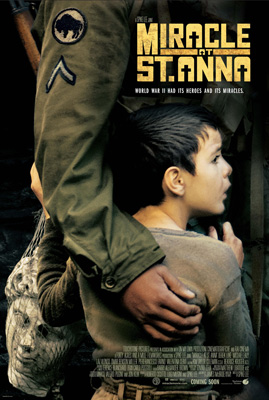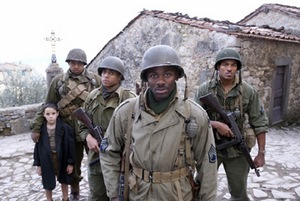- Comics
- Comics Reviews
- Manga
- Comics Reviews
- European Comics
- News
- Comics News
- Press Releases
- Columns
- Spotlight
- Digital Comics
- Webcomics
- Cult Favorite
- Back Issues
- Webcomics
- Movies
- Toys
- Store
- More
- About
By Leroy Douresseaux
September 25, 2008 - 11:04
 |
MIRACLE AT ST. ANNA
Touchstone Pictures Presents
In Association with On My Own, Produzioni Cinematografiche, and Rai Cinema
A 40 Acres and a Mule Filmworks Productions
Miracle at St. Anna (2008)
DIRECTOR: Spike Lee
WRITER: James McBride (based upon his novel)
PRODUCERS: Roberto Cicutto, Luigi Musini, and Spike Lee
CINEMATOGRAPHER: Matthew Libatique, A.S.C. (D.o.P.)
EDITOR: Barry Alexander Brown
PRODUCTION DESIGNER: Tonino Zera
COSTUME DESIGNER: Carlo Poggioli
COMPOSER: Terrence Blanchard
Starring: Derek Luke, Michael Ealy, Laz Alonso, Omar Benson Miller, Pierfrancesco Favino, Valentina Cervi, and Matteo Sciabordi, John Turturro, Joseph Gordon-Levitt, John Leguizamo, Kerry Washington, D.B. Sweeney, and Robert John Burke
Opening date: Friday, September 26, 2008
Running time: 160 minutes
Rating: MPAA – R for strong war violence, language, and some sexual content/nudity
Miracle at St. Anna is the new film from director Spike Lee (Do The Right Thing, Inside Man). A gripping World War II epic, it looks at an all-black Army division stationed in Italy and trapped behind enemy lines during WWII. The film is based on a novel of the same name written by James McBride, who also wrote the screenplay.
Miracle at St. Anna follows four soldiers from the army's Negro 92nd Infantry Division (Buffalo Soldiers) who find themselves separated from their unit and behind enemy lines. They risk their lives for a country in which they are treated with less respect than the enemy they are fighting. The four men discover humanity in St. Anna di Stazzema, a small Tuscan village on the Gothic Line when one of them risks his life to save an Italian boy.
This story is inspired by the August 1944 Sant'Anna di Stazzema massacre, which was perpetrated by the Waffen-SS in retaliation for Italian partisan activity. Miracle at St. Anna’s plot also involves a sculpted head from Ponte Santa Trinita in Florence.
From the Miracle at St. Anna press kit:
SOLDIERING FOR STORY
Author James McBride Turns Childhood Stories—and Years of Research—into a Novel and Script
The story behind “Miracle at St. Anna” is rooted in a Brooklyn, NY, brownstone some four decades ago, thanks to the uncle of a young boy who would grow up to be acclaimed writer James McBride. Uncle Henry shared first-hand accounts of WWII, Italian battles and the relationships formed overseas, but young James didn’t yet recognize the value of the stories. “My uncle used to talk about how great the Italians were,” says McBride. “He used to tell war stories which—at the time—us kids ignored.”
It would be years and long after the death of Henry when McBride would recall some of the details his uncle revealed. “He used to talk about how the Italians loved the soldiers there, the black soldiers. So I investigated it and discovered that there was an entire division of blacks in Italy as combat infantry. That’s how I found out about the 92nd Division.”
The 92nd Infantry Division consisted of 15,000 African-American men—dubbed Buffalo Soldiers—who served in Italy during World War II from August 1944 to November 1945. They weren’t the first African Americans to fight for the U.S., in fact, the term Buffalo Soldier dates back to the Mexican War. “Buffalo Soldier was a nickname that the Native Americans gave to the black members of the 9th and 10th Cavalries because of their dark skin and hair that was akin to their beloved buffalo,” says McBride.
The 92nd became the foundation of McBride’s novel “Miracle at St. Anna,” which was published in 2003. It earned an instant fan in Spike Lee. “I called James and told him I would like to make this into a film,” says the director. “I became a student of World War II, in particular a student of the 92nd Infantry Division, the Buffalo Soldiers.
“James introduced me to several of the surviving Buffalo Soldiers whom he met and interviewed for the novel,” Lee continues. “They saw things that you would not want anybody to see—the horrors of war: moments that they still think about, still dream about, still wake up in a sweat about.”
Lee decided that McBride was the best person to write the screenplay for the film. “James is the sole author of the script,” says Lee. “I think he did a great job, but he had great material to work with: the novel he wrote.”
McBride says it took years to pull the story together. “A story like this doesn’t tell itself,” he says. “‘Miracle at St. Anna’ was never written as a war story, it was written as a story about human beings who are reacting in times of extraordinary stress, trying to retain their humanity.”
Producer Luigi Musini adds, “It’s about friendship and about getting to know each other behind fears and prejudices. It’s about helping each other. It’s about the extraordinary encounter of different people, blacks and whites, old people and children, Italians and Americans and Germans, all in the midst of a war.”
“In order to do that kind of story,” concludes McBride, “you have to really be familiar with that world.”
 |
| A boy and his four heroes in this image for the film. |
The author did more than become familiar with the world, he immersed himself in it. “I studied Italian at The New School in New York City. I moved to Italy with my family for six months. I interviewed dozens of Italians—Partisans and Fascists. I interviewed dozens of African-American soldiers who fought in the war, most who have since passed away. I must have read at least 20 books. I went to the Army War College in Carlisle, Pennsylvania. I studied the whole business of what the 92nd did in Italy during the war, to try to get an idea of what really transpired.”
With a solid understanding of the history, McBride was able to create the story, weaving in real-life elements he’d learned: actual Buffalo Soldiers may have influenced a character trait along the way and their stories helped shape battle scenes and allowed McBride to depict how these soldiers were often treated. While the story is fictional, says McBride, there is truth at its core.
“The film opens with what seems like the murder of an innocent man at the post office,” says McBride.
The rest of the story helps explain why it happens, who the players are and what event which turns out to be a true atrocity in Italian history—leads to this present-day murder at a New York City post office.
“A reporter decides to investigate and discovers a priceless Italian artifact in the suspect’s apartment,” says McBride. “The artifact leads to a long-forgotten division that fought in World War II.”
The story goes across the ocean and back in time as a group of soldiers from the 92nd Division attempt to cross the Serchio River in Tuscany, Italy, in September of 1944. In many ways, says Lee, this is where the real story begins.
“Four men get caught behind enemy lines and they befriend a traumatized young Italian boy,” says Lee. “They find themselves in a remote Tuscan village—with people who’ve never seen a black person before. It’s about how they all overcome these barriers—cultural, language—and try to form an allegiance for the oncoming Nazi attack.”
Producer Roberto Cicutto adds, “It is about relationships between people who would have never met in ordinary life and who understand and help each other against the horror of the war.”
Says McBride, “I think these kinds of stories can be told in a way that doesn’t really point a finger at any particular person or society but just show how difficult life was, not only for the Buffalo Soldiers who were fighting in Italy, but for the Italians, as well as many of the Germans. “You could say it’s a war movie,” continues McBride. “You could say it’s a movie about a boy and a man.
You could say it’s a movie about Americans and Italians. You could say it’s a movie about a German who does the right thing. But the film is ultimately about the miracle of love between human beings and the choices they make in the face of enormous adversity.”
McBride says it was tough at first to transform the novel into a movie. “As a novelist, you tend to think internally,” he says. “You can guide what the character says and you can explore what he or she is thinking. Movies don’t have time to explain. You have to get right to the muscle.”
The author adds that he didn’t mind handing over control of what had been his baby for so long. “It was nice to see somebody else put their vision to it. I happen to like Spike’s vision. I trust it. It’s like jazz…everyone adds their own particular flavor and color and that’s what creates the song.”
Visit the Miracle at St. Anna film site.